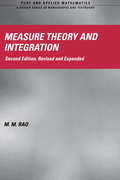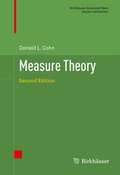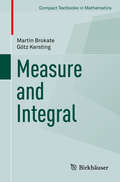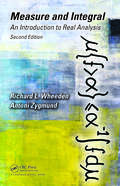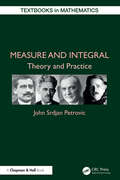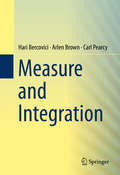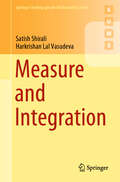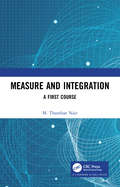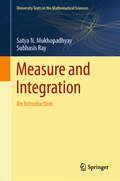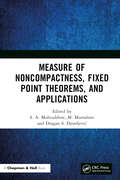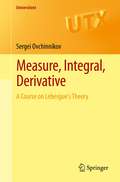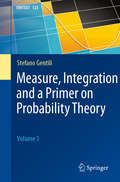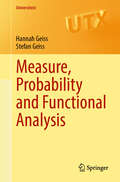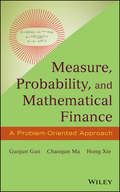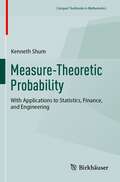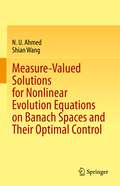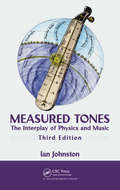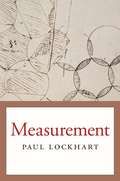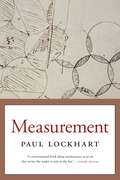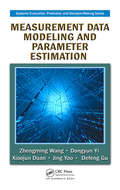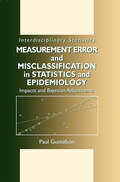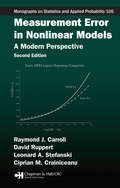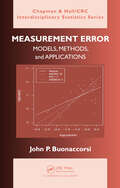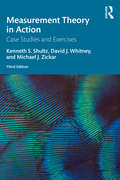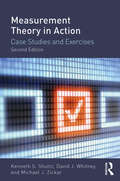- Table View
- List View
Measure Theory and Integration (Chapman & Hall/CRC Pure and Applied Mathematics #Vol. 266)
by M. M. RaoSignificantly revised and expanded, this authoritative reference/text comprehensively describes concepts in measure theory, classical integration, and generalized Riemann integration of both scalar and vector types-providing a complete and detailed review of every aspect of measure and integration theory using valuable examples, exercises, and applications.With more than 170 references for further investigation of the subject, this Second Editionprovides more than 60 pages of new information, as well as a new chapter on nonabsolute integralscontains extended discussions on the four basic results of Banach spacespresents an in-depth analysis of the classical integrations with many applications, including integration of nonmeasurable functions, Lebesgue spaces, and their propertiesdetails the basic properties and extensions of the Lebesgue-Carathéodory measure theory, as well as the structure and convergence of real measurable functionscovers the Stone isomorphism theorem, the lifting theorem, the Daniell method of integration, and capacity theoryMeasure Theory and Integration, Second Edition is a valuable reference for all pure and applied mathematicians, statisticians, and mathematical analysts, and an outstanding text for all graduate students in these disciplines.
Measure Theory: Second Edition
by Donald L. CohnIntended as a self-contained introduction to measure theory, this textbook also includes a comprehensive treatment of integration on locally compact Hausdorff spaces, the analytic and Borel subsets of Polish spaces, and Haar measures on locally compact groups. This second edition includes a chapter on measure-theoretic probability theory, plus brief treatments of the Banach-Tarski paradox, the Henstock-Kurzweil integral, the Daniell integral, and the existence of liftings. Measure Theory provides a solid background for study in both functional analysis and probability theory and is an excellent resource for advanced undergraduate and graduate students in mathematics. The prerequisites for this book are basic courses in point-set topology and in analysis, and the appendices present a thorough review of essential background material.
Measure and Integral
by Martin Brokate Götz KerstingThe Lebesgue integral is an essential tool in the fields of analysis and stochastics and for this reason, in many areas where mathematics is applied. This textbook is a concise, lecture-tested introduction to measure and integration theory. It addresses the important topics of this theory and presents additional results which establish connections to other areas of mathematics. The arrangement of the material should allow the adoption of this textbook in differently composed Bachelor programmes.
Measure and Integral: An Introduction to Real Analysis, Second Edition (Chapman & Hall/CRC Pure and Applied Mathematics)
by Richard L. WheedenNow considered a classic text on the topic, Measure and Integral: An Introduction to Real Analysis provides an introduction to real analysis by first developing the theory of measure and integration in the simple setting of Euclidean space, and then presenting a more general treatment based on abstract notions characterized by axioms and with less
Measure and Integral: Theory and Practice (Textbooks in Mathematics)
by John Srdjan PetrovicThis accessible introduction to the topic covers the theory of measure and integral, as introduced by Lebesgue and developed in the first half of the 20th century. It leads naturally to Banach spaces of functions and linear operators acting on them.This material in Measure and Integral: Theory and Practice is typically covered in a graduate course and is almost always treated in an abstract way, with little or no motivation. The author employs a plethora of examples and exercises and strives to motivate every concept with its historical background. This textbook is accessible to a wider range of students, including at the undergraduate level.A major problem facing anyone teaching measure theory is how to combine the elementary approach (measure on the real line or in the plane) and the abstract measure theory. The author develops a theory of measure in the plane, then shows how to generalize these ideas to an abstract setting.The result is a textbook accessible to a wider range of students.The material requires a good understanding of topics often referred to as advanced calculus, such as Riemann integration on Euclidean spaces and series of functions. Also, a reader is expected to be proficient in the basics of set theory and point-set topology, preferably including metric spaces.
Measure and Integration
by Hari Bercovici Arlen Brown Carl PearcyThis book covers the material of a oneyear course in real analysis. It includes an original axiomatic approachto Lebesgue integration which the authors have found to be effective in theclassroom. Each chapter contains numerous examples and an extensiveproblem set which expands considerably the breadth of the material covered inthe text. Hints are included for some of the more difficult problems.
Measure and Integration (Springer Undergraduate Mathematics Series)
by Harkrishan Lal Vasudeva Satish ShiraliThis textbook provides a thorough introduction to measure and integration theory, fundamental topics of advanced mathematical analysis.Proceeding at a leisurely, student-friendly pace, the authors begin by recalling elementary notions of real analysis before proceeding to measure theory and Lebesgue integration. Further chapters cover Fourier series, differentiation, modes of convergence, and product measures. Noteworthy topics discussed in the text include Lp spaces, the Radon–Nikodým Theorem, signed measures, the Riesz Representation Theorem, and the Tonelli and Fubini Theorems.This textbook, based on extensive teaching experience, is written for senior undergraduate and beginning graduate students in mathematics. With each topic carefully motivated and hints to more than 300 exercises, it is the ideal companion for self-study or use alongside lecture courses.
Measure and Integration: A First Course
by M Thamban NairThis concise text is intended as an introductory course in measure and integration. It covers essentials of the subject, providing ample motivation for new concepts and theorems in the form of discussion and remarks, and with many worked-out examples. The novelty of Measure and Integration: A First Course is in its style of exposition of the standard material in a student-friendly manner. New concepts are introduced progressively from less abstract to more abstract so that the subject is felt on solid footing. The book starts with a review of Riemann integration as a motivation for the necessity of introducing the concepts of measure and integration in a general setting. Then the text slowly evolves from the concept of an outer measure of subsets of the set of real line to the concept of Lebesgue measurable sets and Lebesgue measure, and then to the concept of a measure, measurable function, and integration in a more general setting. Again, integration is first introduced with non-negative functions, and then progressively with real and complex-valued functions. A chapter on Fourier transform is introduced only to make the reader realize the importance of the subject to another area of analysis that is essential for the study of advanced courses on partial differential equations. Key Features Numerous examples are worked out in detail. Lebesgue measurability is introduced only after convincing the reader of its necessity. Integrals of a non-negative measurable function is defined after motivating its existence as limits of integrals of simple measurable functions. Several inquisitive questions and important conclusions are displayed prominently. A good number of problems with liberal hints is provided at the end of each chapter. The book is so designed that it can be used as a text for a one-semester course during the first year of a master's program in mathematics or at the senior undergraduate level. About the Author M. Thamban Nair is a professor of mathematics at the Indian Institute of Technology Madras, Chennai, India. He was a post-doctoral fellow at the University of Grenoble, France through a French government scholarship, and also held visiting positions at Australian National University, Canberra, University of Kaiserslautern, Germany, University of St-Etienne, France, and Sun Yat-sen University, Guangzhou, China. The broad area of Prof. Nair’s research is in functional analysis and operator equations, more specifically, in the operator theoretic aspects of inverse and ill-posed problems. Prof. Nair has published more than 70 research papers in nationally and internationally reputed journals in the areas of spectral approximations, operator equations, and inverse and ill-posed problems. He is also the author of three books: Functional Analysis: A First Course (PHI-Learning, New Delhi), Linear Operator Equations: Approximation and Regularization (World Scientific, Singapore), and Calculus of One Variable (Ane Books Pvt. Ltd, New Delhi), and he is also co-author of Linear Algebra (Springer, New York).
Measure and Integration: An Introduction (University Texts in the Mathematical Sciences)
by Subhasis Ray Satya N. MukhopadhyayDesigned for senior undergraduate and graduate students in mathematics, this textbook offers a comprehensive exploration of measure theory and integration. It acts as a pivotal link bridging the Riemann integral and the Lebesgue integral, with a primary focus on tracing the evolution of measure and integration from their historical roots. A distinctive feature of the book is meticulous guidance, providing a step-by-step journey through the subject matter, thus rendering complex concepts more accessible to beginners. A fundamental grasp of differential and integral calculus, as well as Riemann integration, is recommended to ensure a smoother comprehension of the material. This textbook comprises 10 well-structured chapters, each thoughtfully organized to lead students from fundamental principles to advanced complexities. Beginning with the establishment of Lebesgue’s measure on the real line and an introduction to measurable functions, the book then delves into exploring the cardinalities of various set classes. As readers progress, the subtleties of the Lebesgue integral emerge, showcasing its generalization of the Riemann integral and its unique characteristics in higher dimensions. One of the book’s distinctive aspects is its indepth comparison of the Lebesgue integral, improper Riemann integral, and Newton integral, shedding light on their distinct qualities and relative independence. Subsequent chapters delve into the realm of general measures, Lebesgue-Stieltje's measure, Hausdorff ’s measure, and the concept of measure and integration in product spaces. Furthermore, the book delves into function spaces, such as 𝘓𝘱 spaces, and navigates the intricacies of signed and complex measures, providing students with a comprehensive foundation in this vital area of mathematics.
Measure of Noncompactness, Fixed Point Theorems, and Applications
by M. Mursaleen S. A. Mohiuddine Dragan S. DjordjevićThe theory of the measure of noncompactness has proved its significance in various contexts, particularly in the study of fixed point theory, differential equations, functional equations, integral and integrodifferential equations, optimization, and others. This edited volume presents the recent developments in the theory of the measure of noncompactness and its applications in pure and applied mathematics. It discusses important topics such as measures of noncompactness in the space of regulated functions, application in nonlinear infinite systems of fractional differential equations, and coupled fixed point theorem.Key Highlights: Explains numerical solution of functional integral equation through coupled fixed point theorem, measure of noncompactness and iterative algorithm Showcases applications of the measure of noncompactness and Petryshyn’s fixed point theorem functional integral equations in Banach algebra Explores the existence of solutions of the implicit fractional integral equation via extension of the Darbo’s fixed point theorem Discusses best proximity point results using measure of noncompactness and its applications Includes solvability of some fractional differential equations in the holder space and their numerical treatment via measures of noncompactness This reference work is for scholars and academic researchers in pure and applied mathematics.
Measure, Integral, Derivative
by Sergei OvchinnikovThis classroom-tested text is intended for a one-semester course in Lebesgue's theory. With over 180 exercises, the text takes an elementary approach, making it easily accessible to both upper-undergraduate- and lower-graduate-level students. The three main topics presented are measure, integration, and differentiation, and the only prerequisite is a course in elementary real analysis. In order to keep the book self-contained, an introductory chapter is included with the intent to fill the gap between what the student may have learned before and what is required to fully understand the consequent text. Proofs of difficult results, such as the differentiability property of functions of bounded variations, are dissected into small steps in order to be accessible to students. With the exception of a few simple statements, all results are proven in the text. The presentation is elementary, where σ-algebras are not used in the text on measure theory and Dini's derivatives are not used in the chapter on differentiation. However, all the main results of Lebesgue's theory are found in the book.
Measure, Integration and a Primer on Probability Theory: Volume 1 (UNITEXT #125)
by Stefano GentiliThe text contains detailed and complete proofs and includes instructive historical introductions to key chapters. These serve to illustrate the hurdles faced by the scholars that developed the theory, and allow the novice to approach the subject from a wider angle, thus appreciating the human side of major figures in Mathematics. The style in which topics are addressed, albeit informal, always maintains a rigorous character. The attention placed in the careful layout of the logical steps of proofs, the abundant examples and the supplementary remarks disseminated throughout all contribute to render the reading pleasant and facilitate the learning process. The exposition is particularly suitable for students of Mathematics, Physics, Engineering and Statistics, besides providing the foundation essential for the study of Probability Theory and many branches of Applied Mathematics, including the Analysis of Financial Markets and other areas of Financial Engineering.
Measure, Probability and Functional Analysis (Universitext)
by Hannah Geiss Stefan GeissThis textbook offers a self-contained introduction to probability, covering all topics required for further study in stochastic processes and stochastic analysis, as well as some advanced topics at the interface between probability and functional analysis. The initial chapters provide a rigorous introduction to measure theory, with a special focus on probability spaces. Next, Lebesgue integration theory is developed in full detail covering the main methods and statements, followed by the important limit theorems of probability. Advanced limit theorems, such as the Berry-Esseen Theorem and Stein’s method, are included. The final part of the book explores interactions between probability and functional analysis. It includes an introduction to Banach function spaces, such as Lorentz and Orlicz spaces, and to random variables with values in Banach spaces. The Itô–Nisio Theorem, the Strong Law of Large Numbers in Banach spaces, and the Bochner, Pettis, and Dunford integrals are presented. As an application, Brownian motion is rigorously constructed and investigated using Banach function space methods. Based on courses taught by the authors, this book can serve as the main text for a graduate-level course on probability, and each chapter contains a collection of exercises. The unique combination of probability and functional analysis, as well as the advanced and original topics included, will also appeal to researchers working in probability and related fields.
Measure, Probability, and Mathematical Finance
by Hong Xie Chaoqun Ma Guojun GanAn introduction to the mathematical theory and financial models developed and used on Wall StreetProviding both a theoretical and practical approach to the underlying mathematical theory behind financial models, Measure, Probability, and Mathematical Finance: A Problem-Oriented Approach presents important concepts and results in measure theory, probability theory, stochastic processes, and stochastic calculus. Measure theory is indispensable to the rigorous development of probability theory and is also necessary to properly address martingale measures, the change of numeraire theory, and LIBOR market models. In addition, probability theory is presented to facilitate the development of stochastic processes, including martingales and Brownian motions, while stochastic processes and stochastic calculus are discussed to model asset prices and develop derivative pricing models.The authors promote a problem-solving approach when applying mathematics in real-world situations, and readers are encouraged to address theorems and problems with mathematical rigor. In addition, Measure, Probability, and Mathematical Finance features:A comprehensive list of concepts and theorems from measure theory, probability theory, stochastic processes, and stochastic calculusOver 500 problems with hints and select solutions to reinforce basic concepts and important theoremsClassic derivative pricing models in mathematical finance that have been developed and published since the seminal work of Black and Scholes Measure, Probability, and Mathematical Finance: A Problem-Oriented Approach is an ideal textbook for introductory quantitative courses in business, economics, and mathematical finance at the upper-undergraduate and graduate levels. The book is also a useful reference for readers who need to build their mathematical skills in order to better understand the mathematical theory of derivative pricing models.
Measure-Theoretic Probability: With Applications to Statistics, Finance, and Engineering (Compact Textbooks in Mathematics)
by Kenneth ShumThis textbook offers an approachable introduction to measure-theoretic probability, illustrating core concepts with examples from statistics and engineering. The author presents complex concepts in a succinct manner, making otherwise intimidating material approachable to undergraduates who are not necessarily studying mathematics as their major. Throughout, readers will learn how probability serves as the language in a variety of exciting fields. Specific applications covered include the coupon collector’s problem, Monte Carlo integration in finance, data compression in information theory, and more. Measure-Theoretic Probability is ideal for a one-semester course and will best suit undergraduates studying statistics, data science, financial engineering, and economics who want to understand and apply more advanced ideas from probability to their disciplines. As a concise and rigorous introduction to measure-theoretic probability, it is also suitable for self-study. Prerequisites include a basic knowledge of probability and elementary concepts from real analysis.
Measure-Valued Solutions for Nonlinear Evolution Equations on Banach Spaces and Their Optimal Control
by N. U. Ahmed Shian WangThis book offers the first comprehensive presentation of measure-valued solutions for nonlinear deterministic and stochastic evolution equations on infinite dimensional Banach spaces. Unlike traditional solutions, measure-valued solutions allow for a much broader class of abstract evolution equations to be addressed, providing a broader approach.The book presents extensive results on the existence of measure-valued solutions for differential equations that have no solutions in the usual sense. It covers a range of topics, including evolution equations with continuous/discontinuous vector fields, neutral evolution equations subject to vector measures as impulsive forces, stochastic evolution equations, and optimal control of evolution equations. The optimal control problems considered cover the existence of solutions, necessary conditions of optimality, and more, significantly complementing the existing literature.This book will be of great interest to researchers in functional analysis, partial differential equations, dynamic systems and their optimal control, and their applications, advancing previous research and providing a foundation for further exploration of the field.
Measured Tones: The Interplay of Physics and Music, Third Edition
by Ian JohnstonMost books concerned with physics and music take an approach that puts physical theory before application. Consequently, these works tend to dampen aesthetic fascination with preludes burdened by an overabundance of algebraic formulae. In Measured Tones: The Interplay of Physics and Music Third Edition, Ian Johnston a professor of astrophysics and
Measurement
by Paul LockhartLockhart's Mathematician's Lament outlined how we introduce math to students in the wrong way. Measurement explains how math should be done. With plain English and pictures, he makes complex ideas about shape and motion intuitive and graspable, and offers a solution to math phobia by introducing us to math as an artful way of thinking and living.
Measurement
by Paul LockhartPaul Lockhart’s Mathematician’s Lament outlined how we introduce math to students in the wrong way. Measurement explains how math should be done. With plain English and pictures, Lockhart makes complex ideas about shape and motion intuitive and graspable, and offers a solution to math phobia by introducing us to math as an artful way of thinking and living.In conversational prose that conveys his passion for the subject, Lockhart makes mathematics accessible without oversimplifying. He makes no more attempt to hide the challenge of mathematics than he does to shield us from its beautiful intensity. Favoring plain English and pictures over jargon and formulas, he succeeds in making complex ideas about the mathematics of shape and motion intuitive and graspable. His elegant discussion of mathematical reasoning and themes in classical geometry offers proof of his conviction that mathematics illuminates art as much as science.Lockhart leads us into a universe where beautiful designs and patterns float through our minds and do surprising, miraculous things. As we turn our thoughts to symmetry, circles, cylinders, and cones, we begin to see that almost anyone can “do the math” in a way that brings emotional and aesthetic rewards. Measurement is an invitation to summon curiosity, courage, and creativity in order to experience firsthand the playful excitement of mathematical work.
Measurement Data Modeling and Parameter Estimation (Systems Evaluation, Prediction, and Decision-Making)
by Xiaojun Duan Zhengming Wang Dongyun Yi Jing Yao Defeng GuThis book discusses the theories, methods, and application techniques of the measurement data mathematical modeling and parameter estimation. It seeks to build a bridge between mathematical theory and engineering practice in the measurement data processing field so theoretical researchers and technical engineers can communicate. It is organized with abundant materials, such as illustrations, tables, examples, and exercises. The authors create examples to apply mathematical theory innovatively to measurement and control engineering. Not only does this reference provide theoretical knowledge, it provides information on first hand experiences.
Measurement Error and Misclassification in Statistics and Epidemiology: Impacts and Bayesian Adjustments (Chapman & Hall/CRC Interdisciplinary Statistics)
by Paul GustafsonMismeasurement of explanatory variables is a common hazard when using statistical modeling techniques, and particularly so in fields such as biostatistics and epidemiology where perceived risk factors cannot always be measured accurately. With this perspective and a focus on both continuous and categorical variables, Measurement Error and Misclassification in Statistics and Epidemiology: Impacts and Bayesian Adjustments examines the consequences and Bayesian remedies in those cases where the explanatory variable cannot be measured with precision. The author explores both measurement error in continuous variables and misclassification in discrete variables, and shows how Bayesian methods might be used to allow for mismeasurement. A broad range of topics, from basic research to more complex concepts such as "wrong-model" fitting, make this a useful research work for practitioners, students and researchers in biostatistics and epidemiology."
Measurement Error in Nonlinear Models: A Modern Perspective, Second Edition (Chapman & Hall/CRC Monographs on Statistics and Applied Probability)
by David Ruppert Leonard A. Stefanski Raymond J. Carroll Ciprian M. CrainiceanuIt's been over a decade since the first edition of Measurement Error in Nonlinear Models splashed onto the scene, and research in the field has certainly not cooled in the interim. In fact, quite the opposite has occurred. As a result, Measurement Error in Nonlinear Models: A Modern Perspective, Second Edition has been revamped and ex
Measurement Error: Models, Methods, and Applications (Chapman & Hall/CRC Interdisciplinary Statistics)
by John P. BuonaccorsiOver the last 20 years, comprehensive strategies for treating measurement error in complex models and accounting for the use of extra data to estimate measurement error parameters have emerged. Focusing on both established and novel approaches, Measurement Error: Models, Methods, and Applications provides an overview of the main techniques and illu
Measurement Theory in Action: Case Studies and Exercises
by David J. Whitney Kenneth S Shultz Michael J ZickarMeasurement Theory in Action, Third Edition, helps readers apply testing and measurement theories and features 22 self-contained modules which instructors can match to their courses. Each module features an overview of a measurement issue and a step-by-step application of that theory. Best Practices provide recommendations for ensuring the appropriate application of the theory. Practical Questions help students assess their understanding of the topic. Students can apply the material using real data in the Exercises, some of which require no computer access, while others involve the use of statistical software to solve the problem. Case Studies in each module depict typical dilemmas faced when applying measurement theory followed by Questions to Ponder to encourage critical examination of the issues noted in the cases. The book’s website houses the data sets, additional exercises, PowerPoints, and more. Other features include suggested readings to further one’s understanding of the topics, a glossary, and a comprehensive exercise in Appendix A that incorporates many of the steps in the development of a measure of typical performance. Updated throughout to reflect recent changes in the field, the new edition also features: Recent changes in understanding measurement, with over 50 new and updated references Explanations of why each chapter, article, or book in each module’s Further Readings section is recommended Instructors will find suggested answers to the book’s questions and exercises; detailed solutions to the exercises; test bank with 10 multiple choice and 5 short answer questions for each module; and PowerPoint slides. Students and instructors can access SPSS data sets; additional exercises; the glossary; and additional information helpful in understanding psychometric concepts. It is ideal as a text for any psychometrics or testing and measurement course taught in psychology, education, marketing, and management. It is also an invaluable reference for professional researchers in need of a quick refresher on applying measurement theory.
Measurement Theory in Action: Case Studies and Exercises, Second Edition
by Kenneth S. Shultz Michael J. Zickar David J. WhitneyThis book helps readers apply testing and measurement theories. Featuring 22 self-standing modules, instructors can pick and choose the ones that are most appropriate for their course. Each module features an overview of a measurement issue and a step-by-step application of that theory. Best practices provide recommendations for ensuring the appropriate application of the theory. Practical questions help students assess their understanding of the topic while the examples allow them to apply the material using real data. Two cases in each module depict typical dilemmas faced when applying measurement theory followed by Questions to Ponder to encourage critical examination of the issues noted in the cases. Each module contains exercises some of which require no computer access while others involve the use of SPSS to solve the problem. The book's website houses the accompanying data sets and more. The book also features suggested readings, a glossary of the key terms, and a continuing exercise that incorporates many of the steps in the development of a measure of typical performance. Updated throughout to reflect recent changes in the field, the new edition also features: --A new co-author, Michael Zickar, who updated the advanced topics and added the new module on generalizability theory (Module 22). -Expanded coverage of reliability (Modules 5 & 6) and exploratory and confirmatory factor analysis (Modules 18 & 19) to help readers interpret results presented in journal articles. -Expanded Web Resources, Instructors will now find: suggested answers to the book's questions and exercises; detailed worked solutions to the exercises; and PowerPoint slides. Students and instructors can access the SPSS data sets; additional exercises; the glossary; and website references that are helpful in understanding psychometric concepts. Part 1 provides an introduction to measurement theory and specs for scaling and testing and a review of statistics. Part 2 then progresses through practical issues related to text reliability, validation, meta-analysis and bias. Part 3 reviews practical issues related to text construction such as the development of measures of maximal performance, CTT item analysis, test scoring, developing measures of typical performance, and issues related to response styles and guessing. The book concludes with advanced topics such as multiple regression, exploratory and confirmatory factor analysis, item response theory (IRT), IRT applications including computer adaptive testing and differential item functioning, and generalizability theory. Ideal as a text for any psychometrics, testing and measurement, or multivariate statistics course taught in psychology, education, marketing and management, professional researchers in need of a quick refresher on applying measurement theory will also find this an invaluable reference.
